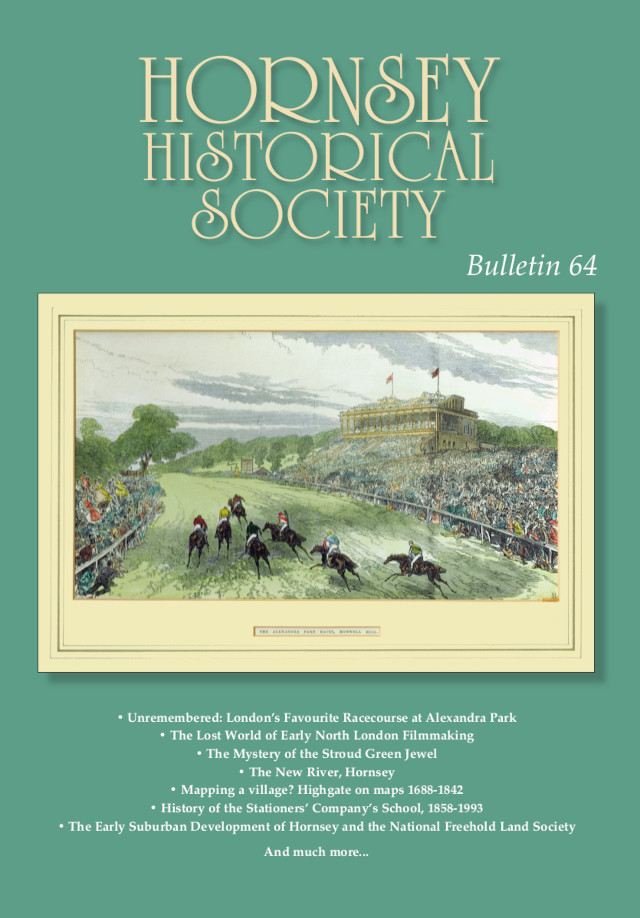Bulletin 64 emerges after another somewhat difficult year for the HHS. In part, this has been due to the effects of the pandemic; but, more problematically, the fact that the majority of the Society’s officers have been in post too long and will be stepping down at the AGM in July without, at this moment, any certainty about their being replaced, is a very serious cause for concern. The Society’s future is genuinely in doubt.

Bulletin 64 again combines articles by familiar contributors with an encouraging number by new ones. There is, as ever, a rich variety.
- Our president, Peter Barber, looks back on the mapping of Highgate over a formative period in the development of that area, demonstrating the unique way that maps can tell stories of social and cultural change.
- Nick Higham’s history of the New River traces the origins of what is actually a man-made aqueduct, created in the 17th century, and the reputation of the man who made it.
- Michael Durham tells the curious story of a short-lived but fascinating institution, ‘The Ancient Corporation of Stroud Green’, which flourished for about 30 years at the end of the 18th century, and may perhaps live again.
- John Hinshelwood argues that urbanisation in Hornsey mainly took place after 1850 in relation to the work of the National Freehold Land Society.
- Stephen Collins traces the history of the Stationers’ Company’s School, a venerable and distinguished establishment, which stood for 90 years on the site now known as Stationers Park until its demise in 1983.
- Hugh Flouch, concerned with play rather than work, describes the rise and flourishing of the Alexandra Park Racecourse in Victorian times, and its sad demise in the later 20th century.
- Alexandra Palace, along with other familiar localities, features in Ian Christie’s article, ‘The Lost World of Early North London Filmmaking’, which reveals the part that three North London locations played in the development of filmmaking in the early years of the 20th century.
- There are also two book reviews, one of which is devoted to the HHS’s newest publication, 100 Stories from the Archive, edited by Janet Owen, Chair of our Publications Committee.
- The appearance of this book, celebrated at a launch in November 2022, represents the highlight of the Society’s year. While 12 other individuals contributed stories, the main work in creating the book was Janet’s, and she is to be hugely congratulated; it is a beautiful production, and a fitting celebration both of our fine and ever-expanding archive and of the work of the Society itself.
It goes without saying that this Bulletin owes much to the help and support of the HHS Publications Committee, most especially to the indefatigable Janet Owen. If you would like to write for the Bulletin, and have an idea about some aspect of our local history, then I’d be delighted to hear from you!
Free to members
The current issue of the Bulletin is free each year to all members. If you aren’t a member and would like to join you can find details on the membership page. As well as the Bulletin, members also receive our quarterly newsletters, free entry to all our monthly lectures and advanced invitations to all special events and outings when they restart.
Buy the Bulletin
Bulletin 64 can be purchased online by non-members for £10.00 +p&p.
We aim to send out all items within 5-7 days, but as a small Society run entirely by volunteers turnaround times may sometimes vary.
Write for the Bulletin
We welcome contributions to the Bulletin from interested authors, who do not need to be members of the Society. Articles for inclusion should be concerned with Hornsey, its residents and its history. A length of about 2-3000 words is suggested, but shorter pieces such as letters or reviews of books about local history can also be accepted.
All articles are read prior to acceptance by members of the Publications Committee, who may suggest revisions. Material should be sent by email attachment in Word format (not PDF) to the Editor, Professor Sandra Clark, who will be happy to deal with any questions about potential contributions. Illustrations are encouraged.